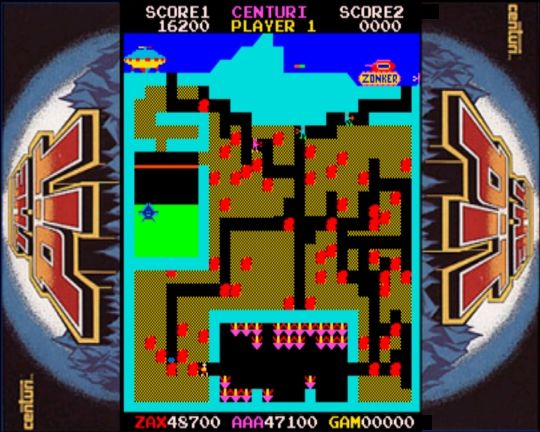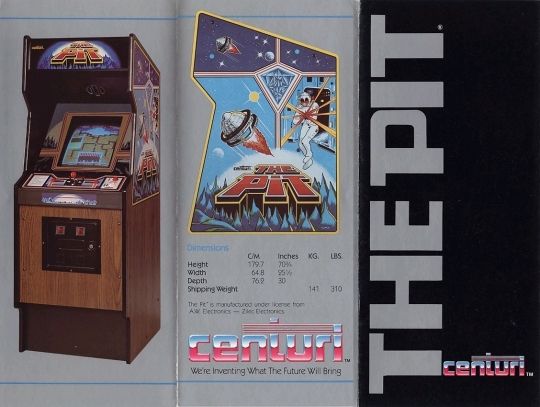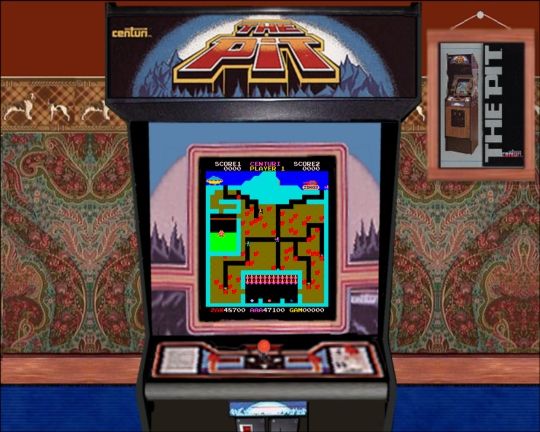|
HAVE YOU MET YOUR
FATHER?
The secret ancestry of classic games.
No.1 - Boulder Dash
Your
correspondent's been known to get irritable when videogame
journalists exciteably acclaim the stunning "originality" of games
which have supposedly appeared out of nowhere, but about which
anyone who knows anything about games knows otherwise. (The most
celebrated - if that's the right word - example of recent years
would probably be Worms, recipient of all sorts of originality
awards despite being simply the latest in a 20-year-old line
encompassing scores of previous games playing in exactly the same
way.)
But sometimes that
ire is a little unwarranted, because some games are so obscure that
it's only by sheer dumb luck that anyone would even have heard of
them, far less be able to identify that they were the estranged
parent of a modern classic. And so it is with Centuri's 1982 coin-op
The Pit - the game that gave birth to Boulder Dash.
(Gave birth to
Boulder Dash at the scandalously young age of two, in fact -
the latter game having been released in 1984 - but let's just skip
over that alarming and disturbing paedo-fact for the sake of decency
and move swiftly on.)

The backdrops seen around the main game screen
on this page are your reporter's
own "bezel" artwork files for MAME, which can be downloaded from
here.
Boulder Dash is
most commonly associated with the two classic earth-shifting arcade
games Dig Dug and Mr Do, but beyond the underground setting it has
almost nothing in common with either title. Dig Dug and Mr Do are
both fundamentally about battling your enemies, not negotiating your
environment. There are no obstacles in your way, and the
rocks/apples which can fall down the screen are really there as
weapons rather than dangers. The Pit is different, though. While
there are enemy characters chasing your diamond-hunting
miner, they're pretty much only a distraction. It's perfectly simple
for even a slightly-skilled player to conduct the first few seconds
of any level in such a way (illustrated in the screenshot above)
that the claw-wielding baddies are confined to a small space at the
upper centre of the pit, well away from anywhere the player needs to
go.
("Any" level is a
slight misnomer, in fact. The game only has two different screens,
actually the same one except for rock placement, which alternate at
ever-increasing pace until everything happens at blinding speed and
becomes as much a test of memory as reflex.)
Your problem in The
Pit is - like Boulder Dash - chiefly to navigate your way safely
around each level in order to collect some diamonds and then get out
of the exit without having a rock fall on your head. (Also like
Boulder Dash, you don't have to collect all of a level's
diamonds, but there are temptingly large bonuses for picking up more
than the minimum.) There are walls, bottlenecks, rooms and
environmental hazards, as well as the liberal scattering of rocks
that constitutes the core gameplay element of both titles.

Oddly, the cabinet art doesn't depict any kind
of pit or underground environment at all.
The similarities
don't end there, though. For one thing, your miner doesn't just
plough through earth like in Dig Dug and Mr Do. To make a tunnel, he
blasts away a square of space with his, um, anti-dirt laser, then
pauses for a moment before moving into the gap. (This is very much a
character-block-centred game, which makes it all the weirder that
nobody ever converted it to the Speccy. There were unofficial ports
to the VIC-20 and the C64 though, one of the very
few advantages of
the CBM machines over the rubber-keyed wonder.) The skilled player,
however, can use this behaviour to take out a square of earth and
then quickly move off in a different direction, in a manner very
akin to the Boulder Dash trick of holding down the fire button to
dig/push/pick up something without moving into its space. In both
games, it's a subtle play mechanic that separates the novice player
from the expert.
And lastly, there's
the behaviour of the enemy characters. The little grab-robots don't
actually chase you - like all the moving enemies in Boulder Dash,
they follow fixed movement patterns (if there's a space below, go
down, if you can't go down go left, etc) and only kill you if you
get very close to them, at which point they leap on you and smush
you. And as in Boulder Dash, they can only move in existing tunnels
- they can't dig their own. And yet despite all this - their slow
pace, limited abilities, lack of weaponry, rigidly-dictated movement
and non-vindictive nature, you'll really come to hate the little
sods. (Maybe it's the way there's a brief but violent struggle when
one attacks you, a bit like in
Maziacs but with the crucial difference that you never ever win.
It looks like a brutal way to die.) Anyone who's ever cursed a
featureless square "enemy" in BD will know the feeling.

Your reporter's unfortunately-decorated virtual
arcade in all its glory.
There isn't really
much else to say about The Pit. It's an incredibly simple game, and
Boulder Dash certainly evolved it a long way - we're not talking
about a ripoff clone
here. But nevertheless, the family resemblance between the two
titles is huge, and there can be little doubt that the creators of
Boulder Dash had their creative fires sparked by The Pit. What
resulted is a game with a pretty different feel, but all the same
DNA. For all their many advanced features and tweaks, there's hardly
anything in any of the
numerous Boulder Dash games that doesn't have its genesis in The
Pit's crude blueprint. Rocks, diamonds, walls, tunnels and
regimented bad guys - it's all here.
The Pit is one of
the games from the early days of the arcades that does still stand
the test of time. Tackle it now and while you'll grasp the rules in
seconds, you'll still get repeatedly pasted by the game's inert
hazards and semi-accidental enemies, angrily piling in more credits
for another try at reaching the adrenalin-pumping later stages. Give
it a go (in
MAME, natch) and find out for yourself.
And if you want to
see where it all ultimately led, check out the superb
Boulder
Dash Xmas 2002 Edition, which is the finest Boulder Dash game
ever (playable for free online, or with a full-featured downloadable
version for about 11 quid). But that's another article altogether.
|

